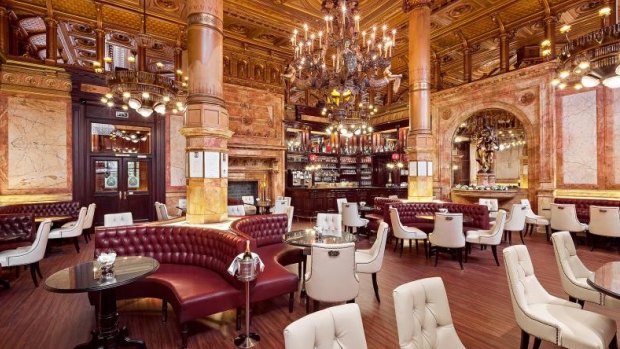This was published 7 years ago
Countries that invented the world's most famous cocktails: Best places and bars to have a classic cocktail
It takes an awful lot of serendipity for a cocktail to become an all-time classic. First, someone needs to stumble across the right combination of ingredients. And then it needs to catch on, with a name that sticks. A good origin story kinda helps as well, although surprisingly few of the great cocktails are still served in the places they were first concocted. Some – such as the old fashioned or mojito – are too difficult to pin to a particular birthplace, while others are from bars that have long closed down. But there are still a few where the pilgrimage is possible …
The Negroni – Caffe Giacosa, Florence
In 1919 or 1920 (accounts vary), Count Camillo Negroni wanted something a little stronger while perched in his regular haunt, the Caffe Casoni. He asked bartender Fosco Scarselli to replace the soda in his Americano with gin, which he had developed a taste for while in Britain. And Scarselli, wanting to signify that it was a different drink, replaced the lemon peel with orange peel. So the vermouth, Campari and gin mix was born.

This bar in Hotel Metropole, Brussels is the birthplace of the black Russian. Credit: metropolehotel.com
The Casoni is now the Caffe Giacosa, owned by fashion designer Roberto Cavalli and deliberately restored to look like a classic European grand cafe where the great and good would meet. See caffegiacosa.com
The Pina Colada – Caribe Hilton, Puerto Rico
Bartender Ramon Marrero apparently spent three months in 1954 trying to capture the flavours of Puerto Rico in a drink. He eventually settled on a recipe that blended rum, coconut cream, heavy cream, crushed ice and fresh pineapple juice, which became known as the pina colada. Marrero stayed working at the Caribe for another 35 years, by which time he had become something of a legend. And that status was confirmed in 1978, when the pina colada was officially designated as Puerto Rico's national drink. The hotel is still open, on the beachy outskirts of the capital, San Juan – and the bar struggles to convince patrons to try anything else. See caribehilton.com
The Mai Tai – Trader Vic's, Emeryville, California
As with many cocktails, the origins of the mai tai are contested, but the most likely claimant is Victor Bergeron, owner of the original Trader Vic's in Emeryville, between Berkeley and Oakland on the San Francisco Bay.
The Trader Vic's version of the origin story is that Vic pulled out a bottle of 17-year-old Jamaican Rum, "added a squeeze of lime, a dash of rock candy syrup, a splash of orange curacao and some French orgeat." He then handed it to a Tahitian friend, who said "It's mai tai roa ae!" – which is Tahitian for "It's out of this world. The best!" See tradervics.com
The Singapore Sling – Raffles, Singapore
Few cocktails have as strong a geographical connection with their birthplace as the Singapore Sling. In 1915, Ngiam Tong Boon was working at the Long Bar in Singapore's Raffles hotel, where at the time it wasn't the done thing for women to be seen drinking in public. So he rustled something up that would disguise the alcohol and have a lady-like colour. And under the currently accepted recipe, that means gin, Cointreau, cherry brandy and Benedictine are covered up in pineapple juice, lime juice and grenadine. The Long Bar is still a Singapore icon – famous for allowing guests to throw peanut shells all over the floor. See raffles.com/Singapore
The Black Russian – Hotel Metropole, Brussels
The oldest standing hotel in Brussels, the Metropole has long hosted more than its fair share of dignitaries. And the combo of five parts vodka to two parts coffee liqueur was first knocked up in honour of Perl Mesta, the US Ambassador to Luxembourg, who happened to be there when Gustave Tops was manning the bar in 1949. The bar is currently getting a refurb, but will be open again once the paint is dry. See metropolehotel.com
The Sidecar – The Ritz, Paris
Another hotel with a cocktail claim to fame is the Ritz in Paris, where legend has it that the sidecar was created shortly after World War I. Apparently an American army captain would regularly rock up in the evenings in a motorcycle sidecar, and the mix of cognac, triple sec and lemon juice got its name from there. It was originally equal measures, but it the recipe was later adapted in London so that the cognac dominated. The Hemingway Bar at the Ritz still serves a very special (and incredibly expensive) version known as the Ritz Sidecar, which uses a rare, old cognac well beyond the price range of mere mortals. See ritzparis.com
The Bellini – Harry's Bar, Venice
Of all the cocktail birthplaces that still stand today, surely none milks it quite as much as Harry's Bar in Venice. Perched on the edge of St Mark's Square, Harry's is well known for borderline extortionate prices, former patrons including Ernest Hemingway and Orson Welles – and creating the Bellini. Bar founder Giuseppe Cipriani created the combo of prosecco and peach puree, although the year it was first created isn't certain. Apparently the drink got the name courtesy of 15th-century artist Giovanni Bellini – the pink colour reminded Cipriani of a monk's toga in one of Bellini's paintings. See harrysbarvenezia.com
Sign up for the Traveller Deals newsletter
Get exclusive travel deals delivered straight to your inbox. Sign up now.